Traveling Exhibition
*Devorah Sperber: Threads of Perception
An
expanded version of the exhibition
The Eye of the Artist: The Work of Devorah Sperber
which debuted at the Brooklyn Museum in 2007
will travel to:
MASS
MoCA
2008
Boise Art Museum June 20- September 20, 2009
Knoxville Museum of Art October 30, 2009- January 7, 2010
Kimball Art Center, August 21- October 31, 2010
*60 page catalog was published in conjuntion with the traveling exhibition

"The Eye of the Artist: The Work of Devorah Sperber," Brooklyn
Museum, 2007
![]() Podcast Audio: Marilyn Kushner interviewing Devorah Sperber
Podcast Audio: Marilyn Kushner interviewing Devorah Sperber
Click on headset icon, then click on download
the podcast. Minimize podcast window to listen to interview
while continuing to view images on devorahsperber.com
Interested in the links between art, science, and technology through the ages, New York artist, Devorah Sperber deconstructs familiar images to address the way the brain processes visual information versus the way we think we see. “As a visual artist,” she says, “I cannot think of a topic more stimulating and yet so basic than the act of seeing—how the human brain makes sense of the visual world.”
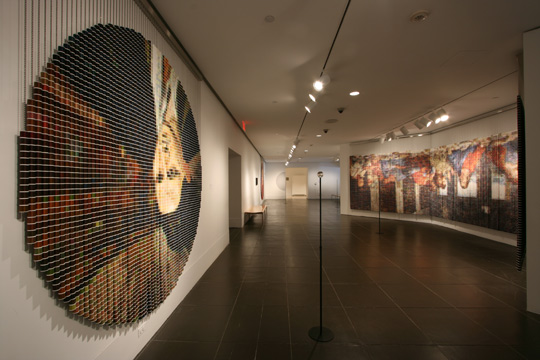
Using ordinary spools of thread, Sperber creates pixilated, inverted images of masterpieces, which appear as colorful abstractions to the naked eye. When viewed with optical devices, however, the works becomes immediately recognizable as the famous paintings.
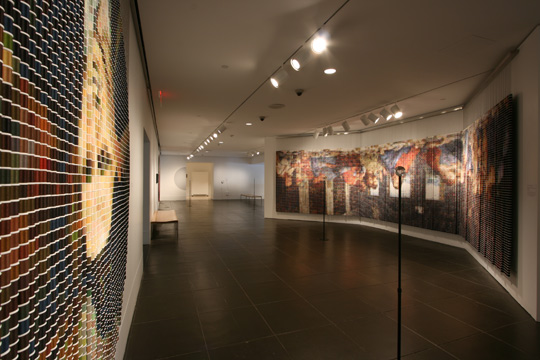
The thread spools works are hung upside down in reference to the fact that the lens of the eye projects an inverted image of the world onto the retina, which is corrected by the brain. A clear acrylic sphere, positioned in front of each work, functions like the human eye and brain, not only inverting but also focusing the image so that it appears as a sharp, faithful, right-side-up reproduction of the famous painting.
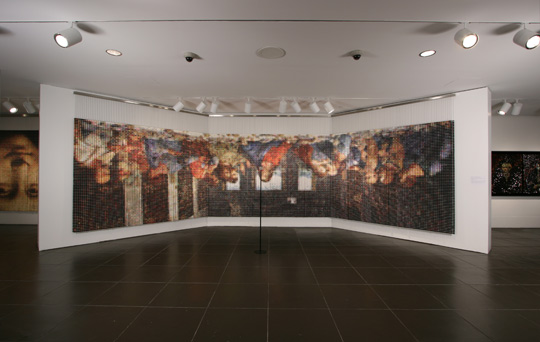
The Eye of the Artist: The Work of Devorah Sperber includes three thread spool installations which debuted at the 2005 International Ljubljana Print Biennial, where she represented the Brooklyn Museum and the USA, including full scale re-creations of Leonardo da Vinci's Last Supper (29 feet wide) and Mona Lisa (30 x 21 inches).

The concept was based on the technology of print making and how mechanical reproductions alter images and the scale of artworks as they exist in “the mind’s eye”. Sperber selected The Last Supper and Mona Lisa because they are two of the most recognizable and reproduced images in the history of art.
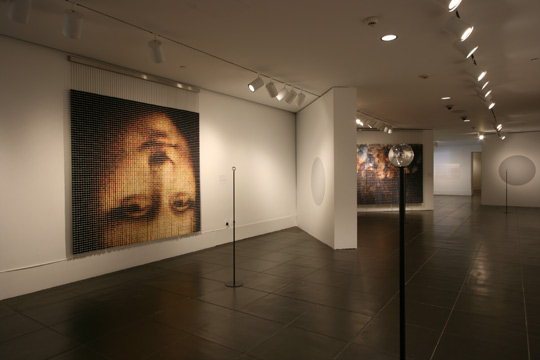
Also on display are Ms. Sperber’s recreations of Picasso's portrait Gertrude Stein and van Eyck's Man in a Red Turban, composed of thousands of Swarovski crystals and thread spools.
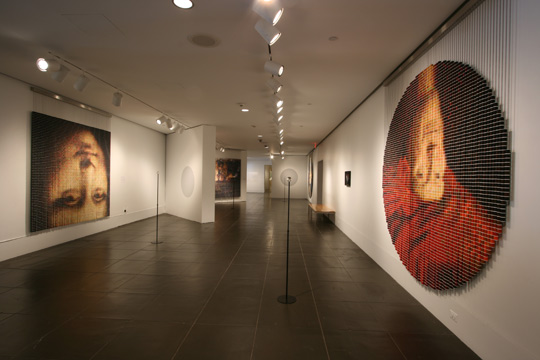
This
new series is based on a recent scientific survey of 3/4 view portraits
over the past two millennia which revealed that one eye of the sitter
is commonly located at or near the vertical center of the composition.
The study suggests that the human brain is hard-wired to respond to
symmetry and that the centering of one eye is appreciated at a subconscious
level in the brain. Ms. Sperber stumbled upon this survey while researching
the Mona Lisa and Last Supper, both of which happen
to be perfect examples of eye-centeredness.
After The Last Supper, 2005
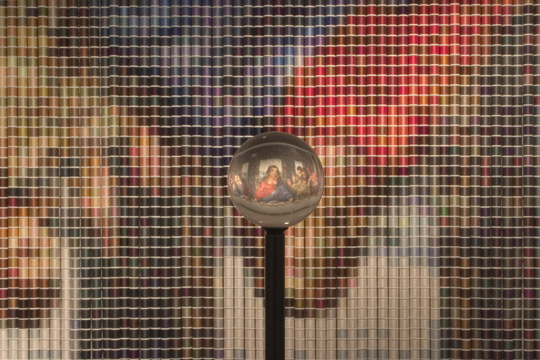
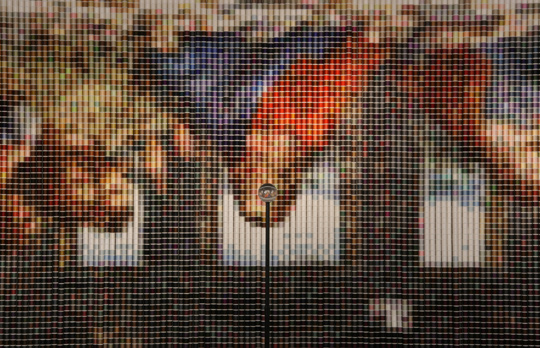

Installation view: "After the Last Supper"
Description: a life sized (29' w) rendering of Leonardo da Vinci's The Last Supper constructed from 20,736 spools of thread. When seen with the aid of optical devices, the spools of thread coalesce into realistic images of Christ and his disciples.
The thread spool columns are strung onto aluminum ball chain and hang to form an open-ended trapezoid. Like the original mural, the Christ figure's right eye is centered and serves as the single vanishing point. The two 45 degree angles of the trapezoid reference the site-specific nature of the original mural (the illusion of being an extension of the interior architecture).
When seen with the naked eye, the spools of thread appear as an abstract arrangement of multi-colored blocks/3D pixels, further abstracted by the fact that The Last Supper imagery is upside down and backwards. The clear acrylic viewing spheres rotate the imagery 180 degrees back to the correct orientation and condense the individual pixels/spools of thread into recognizable images. In addition, each sphere offers a different monocular view of the work, accentuating the illusion of 3 dimension as it exists in flat paintings. Leonardo da Vinci understood that the illusion of 3D in paintings was derived from monocular, not binocular, vision.
The original mural is highly symmetrical, with the right eye of the Christ figure as the single, centered vanishing point, from which all compositional elements project. In this installation, the vanishing point, also Christ's right eye is slightly lower than eye level. Because the spheres rotate the imagery 180 degrees, viewers have the illusion of looking up at the image, replicating the orientation of viewers to the original mural.
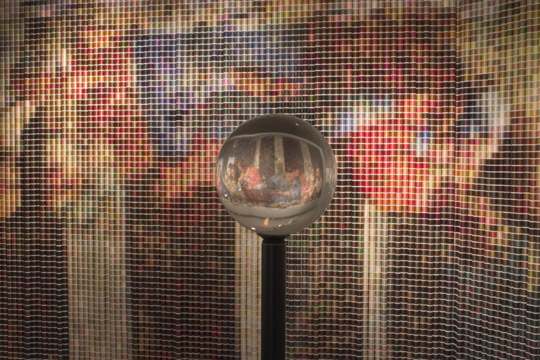
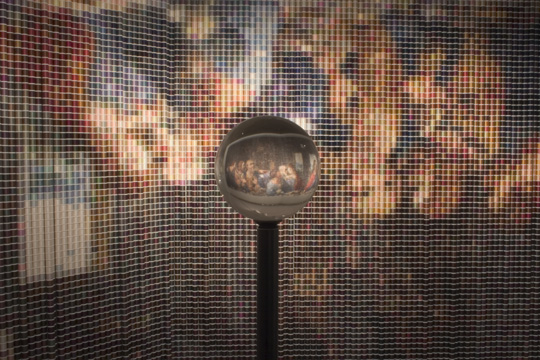
Detail view of right panel: After The Last Supper
After The Mona Lisa 1, 2005
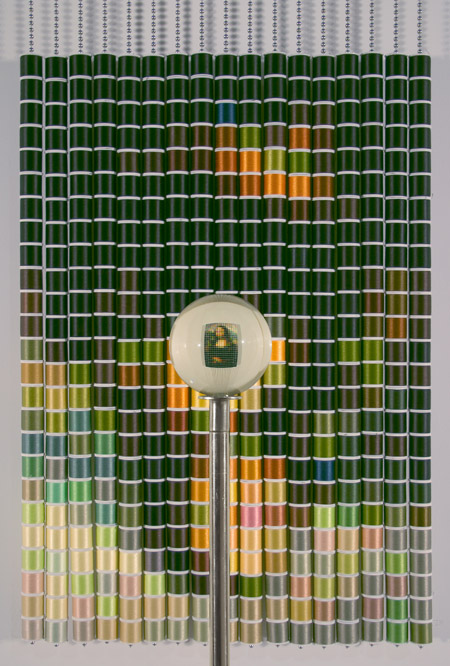
Description: a life-sized rendering of Leonardo da Vinci's Mona Lisa. The work is constructed from only 425 spools of thread resulting in extremely low image resolution. Yet when seen with an optical device, the thread spools condense into a blurred yet recognizable image, conveying how little information the brain needs to make sense of visual imagery.
This concept was explored by self-described "Cyberneticist," Leon Harmon of Bell Labs in 1973. His early pixilated image was included in an article for Scientific American in November 1973, titled "The Recognition of Faces" as a demonstration of the minimum conditions needed to recognize a face.
After the Mona Lisa 2, 2005
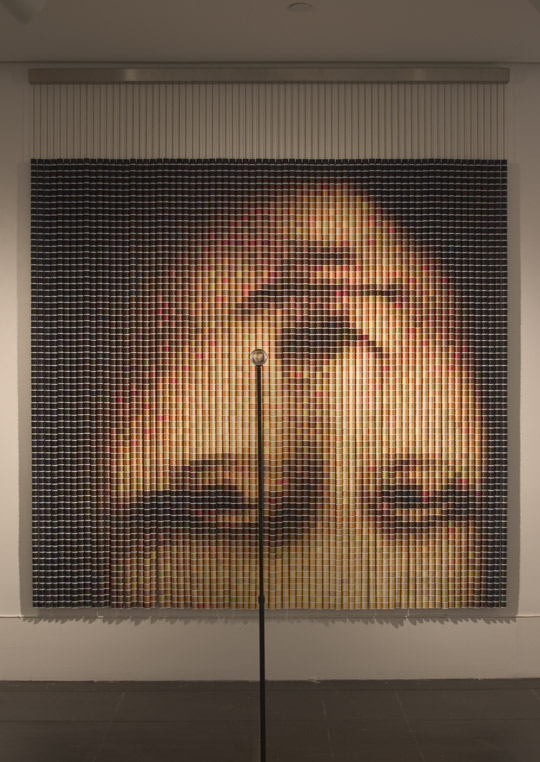
Description: an enlarged rendering of The Mona Lisa's face. When seen with the aid of several viewing spheres, distorted views of The Mona Lisa's elusive smile mimic "low spatial frequencies" usually seen only with peripheral vision. Unlike the original painting, in which her smile is only visible with peripheral vision, in this rendition The Mona Lisa's smile appears, morphs, and disappears in a dramatic and humorous fashion.
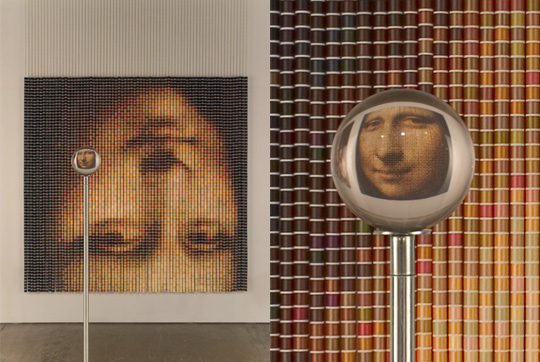
The following works are selections from the new series: 6 Eye-Centered Portraits. The concept was inspired by a recent scientific survey by Christopher Tyler of 3/4 view portraits over the past two millennia which revealed that one eye tended to be placed symmetrically at or near the vertical axis of the canvas throughout the history or Western portraiture.
After van Eyck, 2006
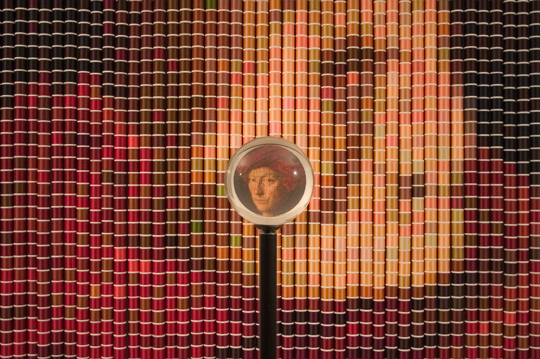
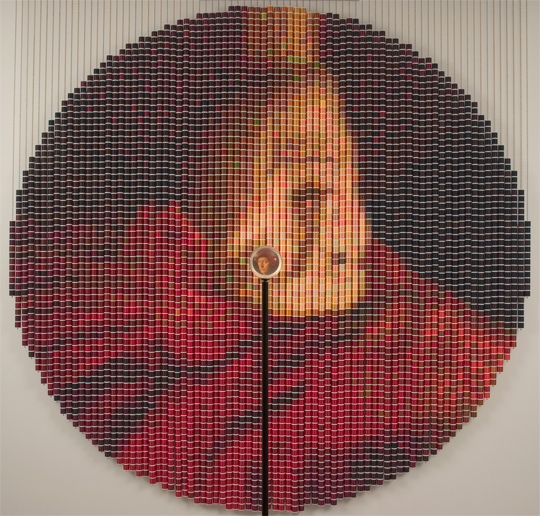
Studio View: "After van Eyck," 2006, by Devorah Sperber, 5,024 spools of thread, stainless steel ball chain and hanging apparatus, clear acrylic viewing sphere, metal stand (104"-122" h x 100” w x 60” d)
After van Eyck (Man with a Red Turban), 2006

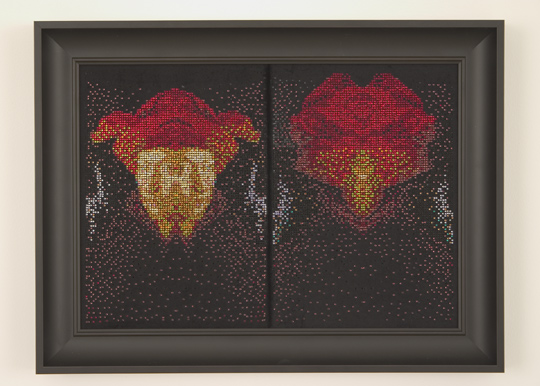
"After van Eyck, (Man with a Red Turban)" 2006, by Devorah Sperber, thousands of Swarovski crystals, black velvet, (14"h X 18 3/4"w). Images created by dividing the original portrait along the vertical axis and mirroring each side to create two symmetrical images.
After Picasso, 2006
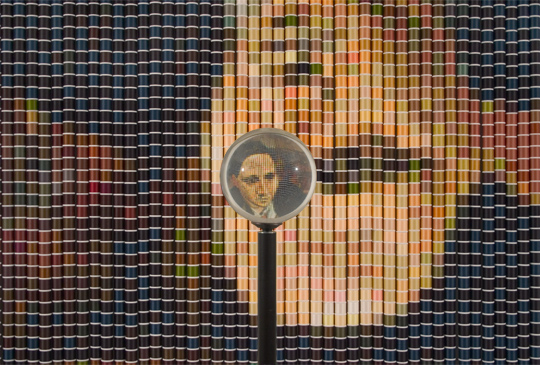
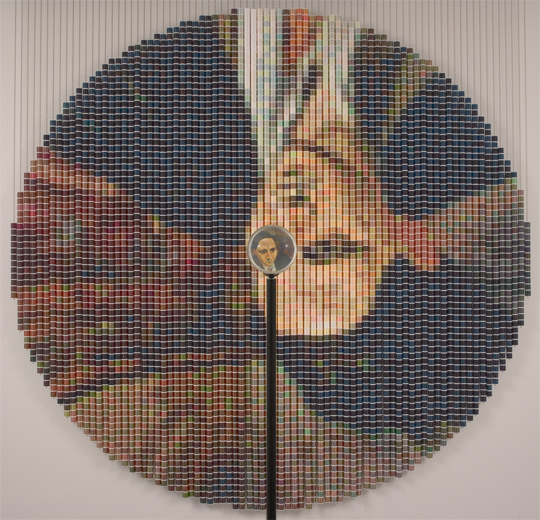
"After Picasso," 2006, by Devorah Sperber, 5,024 spools of thread, stainless steel ball chain and hanging apparatus, clear acrylic viewing sphere, metal stand (104"-122" h x 100” w x 60”- 72"d) This work not part of the traveling exhibition.
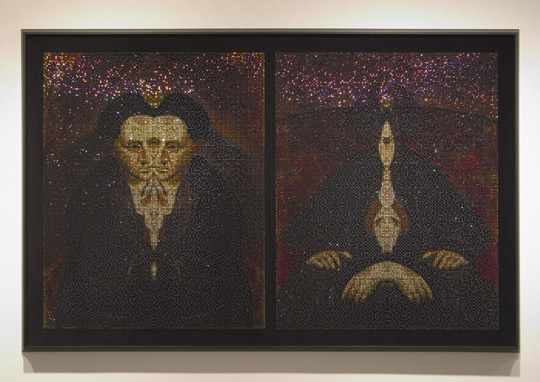
"After Picasso (Gertrude Stein)," 2006, by Devorah Sperber, thousands of Swarovski crystals, black velvet, (47"h x 72.5"w). Images created by dividing the original portrait along the vertical axis and mirroring each side to create two symmetrical images. This work not part of the traveling exhibition.
Works added to the Traveling Exhibition (not exhibited at the Brooklyn Museum)
After Vermeer 2, 2006

"After Vermeer 2," 2006, by Devorah Sperber, 5,024 spools of thread, stainless steel ball chain and hanging apparatus, clear acrylic viewing sphere, metal stand (104"-122" h x 100” w x 60”- 72"d)
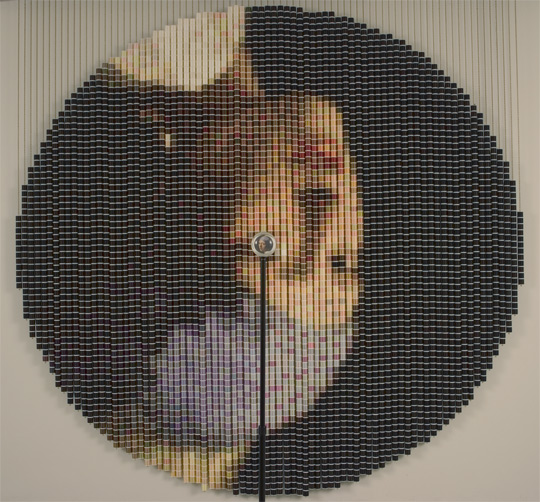
Detail View: "After Vermeer 2," 2006, by Devorah Sperber, 5,024 spools of thread, stainless steel ball chain and hanging apparatus, clear acrylic viewing sphere, metal stand (104"-122" h x 100” w x 60”- 72"d)
After da Vinci (Lay with an Ermine), 2006

Full View: After da Vinci (Lady with an Ermine), 27" x 38" x
3"
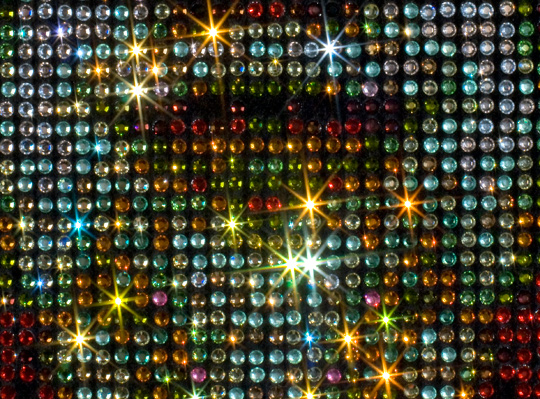
After Dali, After Harmon, 2004
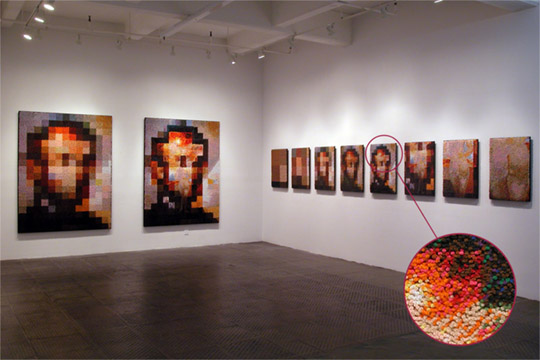
Installation
View: After Dali, After Harmon Series 2004,
2 larger works: 79" x 61" x 3", series of 8 smaller works:
30" x 22" x 3"
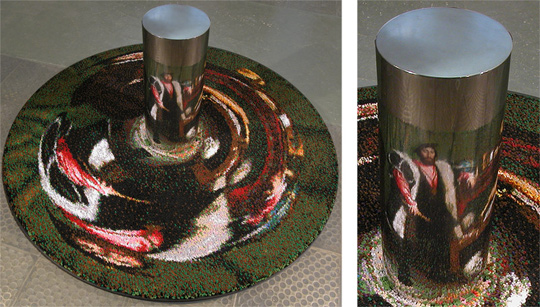
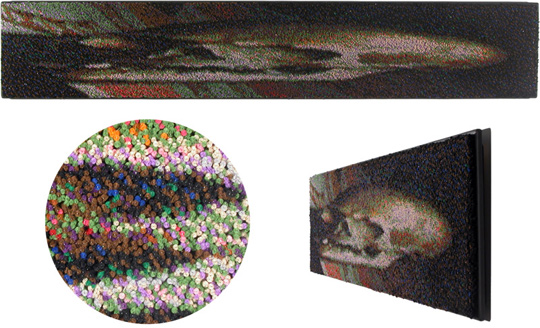
(TOP: full view, Lower Left: detail view, Lower Right: extreme angle) After Holbein 2, 2004, 18.5" x 103" x 3"
Reviews of Debut Exhibition at the Brooklyn Museum, 2007
The
New York Times
(March 23, 2007)
The
New Yorker
(February 19 & 26, 2007)
New
York Sun
(January 25, 2007)
Woodstock
Times
(February 1, 2007)
White
Hot Magazine
(May 2007)
New
Scientist Magazine
(March 17, 2007)
Art
and Living Magazine
(April 2007)
New
York Magazine
(April 2007)
Time
Out New York
(April 2007)
Sculpture
Magazine
(March 2007)
20
Minuten Newspaper
Zurich, Switzerland
(May 4, 2007)
Art
Info.com
(February 7, 2007)
artnet.com
(January, 2007)
Catalogue
Essay by Marilyn Kushner
(2005 Ljubljana Print Biennale)
Devorah Sperber is a New York-based artist whose sculptures, composed of thousands of ordinary objects, negotiate a terrain between low and high tech. Her labor-intensive works explore repetition and the effects of digital technology on perception, scale, and subjective reality. -Patricia Phillips, Executive Editor, Art Journal
© Devorah Sperber Inc. 2000